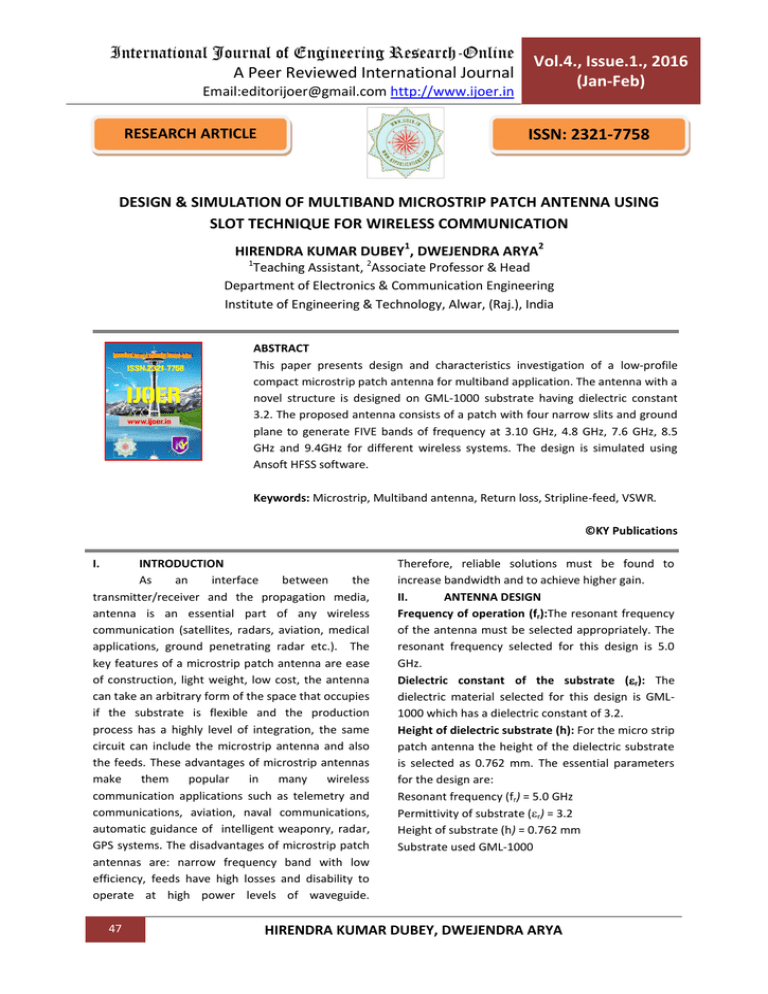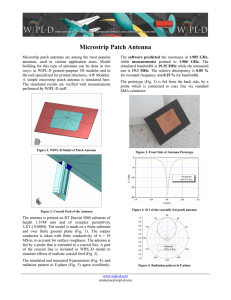PDF F - International Journal of Engineering Research
advertisement

International Journal of Engineering Research-Online A Peer Reviewed International Journal Email:editorijoer@gmail.com http://www.ijoer.in RESEARCH ARTICLE Vol.4., Issue.1., 2016 (Jan-Feb) ISSN: 2321-7758 DESIGN & SIMULATION OF MULTIBAND MICROSTRIP PATCH ANTENNA USING SLOT TECHNIQUE FOR WIRELESS COMMUNICATION HIRENDRA KUMAR DUBEY1, DWEJENDRA ARYA2 1 Teaching Assistant, 2Associate Professor & Head Department of Electronics & Communication Engineering Institute of Engineering & Technology, Alwar, (Raj.), India ABSTRACT This paper presents design and characteristics investigation of a low-profile compact microstrip patch antenna for multiband application. The antenna with a novel structure is designed on GML-1000 substrate having dielectric constant 3.2. The proposed antenna consists of a patch with four narrow slits and ground plane to generate FIVE bands of frequency at 3.10 GHz, 4.8 GHz, 7.6 GHz, 8.5 GHz and 9.4GHz for different wireless systems. The design is simulated using Ansoft HFSS software. Keywords: Microstrip, Multiband antenna, Return loss, Stripline-feed, VSWR. ©KY Publications I. INTRODUCTION As an interface between the transmitter/receiver and the propagation media, antenna is an essential part of any wireless communication (satellites, radars, aviation, medical applications, ground penetrating radar etc.). The key features of a microstrip patch antenna are ease of construction, light weight, low cost, the antenna can take an arbitrary form of the space that occupies if the substrate is flexible and the production process has a highly level of integration, the same circuit can include the microstrip antenna and also the feeds. These advantages of microstrip antennas make them popular in many wireless communication applications such as telemetry and communications, aviation, naval communications, automatic guidance of intelligent weaponry, radar, GPS systems. The disadvantages of microstrip patch antennas are: narrow frequency band with low efficiency, feeds have high losses and disability to operate at high power levels of waveguide. 47 Therefore, reliable solutions must be found to increase bandwidth and to achieve higher gain. II. ANTENNA DESIGN Frequency of operation (fr):The resonant frequency of the antenna must be selected appropriately. The resonant frequency selected for this design is 5.0 GHz. Dielectric constant of the substrate (r): The dielectric material selected for this design is GML1000 which has a dielectric constant of 3.2. Height of dielectric substrate (h): For the micro strip patch antenna the height of the dielectric substrate is selected as 0.762 mm. The essential parameters for the design are: Resonant frequency (fr) = 5.0 GHz Permittivity of substrate (r) = 3.2 Height of substrate (h) = 0.762 mm Substrate used GML-1000 HIRENDRA KUMAR DUBEY, DWEJENDRA ARYA International Journal of Engineering Research-Online A Peer Reviewed International Journal Email:editorijoer@gmail.com http://www.ijoer.in Vol.4., Issue.1., 2016 (Jan-Feb) III. Fig. 1 Microstrip Feed Line The width of the microstrip patch antenna was computed with the following equation: SIMULATION RESULTS The purposed antenna has been simulated using HFSS at 3-9.4 GHz range of frequency. Our design will be primarily to create four narrow slots with different lengths on the antenna. The object is essentially to design an antenna for MULTIBAND application. We perform simulation with software HFSS. 8 where c is the speed of light (3x10 m/s), fr is the operating frequency and r is the dielectric constant. The length of microstrip patch antenna is given by the following equations: where Ereff is the effective dielectric constant and h is the thickness of the dielectric substrate. In the equation above ΔL stands for length extension. Therefore, the actual length of the microstrip patch antenna is given by: Fig.2 Ansoft HFSS generated antenna model We chose a substrate, Calculated the width, length, effective dielectric constant and determined the extent of length and width, which allowed us to have the structure proposed above. The parasitic element can place along the non-radiating edge. Figure 3 shows simulated S parameter Vs frequency plot of the proposed antenna. From this return loss plot it is clear that the antenna is having six bands of operations. The value of return loss are -9.82dB,20.63dB, -23.51dB, -19.50dB and -9.06dB at 3.10GHz, 4.80GHz, 7.6GHz, 8.5GHz and 9.40GHz frequency respectively. S11 parameter obtained at all these frequencies has values less than -10dB. Figure 4 shows simulated VSWR curve of the antenna. The graph indicates that for all six frequencies VSWR is less than 2. The structure of stripline-feed proposed microstrip patch antenna is shown in Figure 1, which is printed on an GML-1000 substrate of thickness 0.762 mm and permittivity 3.2. The antenna structure consists of a rectangular radiating patch; a ground plane and a 50 ohm feed line. Four narrow slots are taken out from the patch. The antenna is occupying an area of 2 20.70X16.53 mm on one side of substrate and an 2 area of 50X50 mm for the ground plane on the other side. Fig. 3 S parameter Vs Frequency plot 48 HIRENDRA KUMAR DUBEY, DWEJENDRA ARYA International Journal of Engineering Research-Online A Peer Reviewed International Journal Email:editorijoer@gmail.com http://www.ijoer.in [4]. [5]. [6]. Fig.4 VSWR Vs Frequency plot This proposed antennas has return loss less than 10dB and VSWR <1.8 for all frequencies. IV. CONCLUSION In this paper design of multiband microstrip patch antenna for wireless system has been proposed and implemented. Simulated and measured results show that the antenna can operate between 3 and 9.4 GHz at multiple frequencies. It is a low-profile antenna which is easy in fabrication. The measured and simulated results are in good agreement. This proposed antennas has return loss less than -10dB and VSWR <1.8 for all frequencies. This antenna is highly suitable for L and S band applications. It can be used for WLAN, WiMAX, WLL and other wireless applications. REFRENCES [1]. Seyed Ehsan Hosseini, Amir Reza Attari, and Aref Pourzadi, A Multiband PIFA with a Slot on the Ground Plane for Wireless Applications, International Journal of Information and Electronics Engineering, Vol. 3, No. 4, July 2013. [2]. Kin-Lu Wong, Compact and Broadband Microstrip Antennas, Jon Wiley & Sons, Inc., 2002. [3]. Jun-Won Kim, Tae-Hwan Jung, Hong-Kyun Ryu, Jong-Myung Woo, Chang-Soo Eun and Dong-Kook Lee, Compact Multiband Microstrip Antenna Using Inverted-L- and TShaped Parasitic Elements, IEEE Antennas and Wireless Propagation, Vol. 12, 2013. 49 [7]. [8]. [9]. Vol.4., Issue.1., 2016 (Jan-Feb) Jaume Anguera, Lluís Boada, Carles Puente, Carmen Borja and Jordi Soler, Stacked HShaped Microstrip Patch Antenna, IEEE Trans. on Antenna and Propagation, Vol. 52, April 2004. A. Janani and A. Priya, Design of E-Shape Fractal Simple Multiband Patch Antenna for S-Band LTE and Various Mobile Standards, International Journal Of Engineering And Science, May 2013. Do-Gu Kang and Y. Sung, Compact Hexaband PIFA Antenna for Mobile Handset Applications, IEEE Antennas and Wireless Propagation, Vol. 9, 2010. M. Siva Ganga Prasad, P. Poorna priya, J. Lavanya, M. S. Rajeev Trivedi, K. Manideep, and V. V. Vamsi siva Krishna, Design of dual and triple band antennas using U-slots on stacked patches, International Journal of Modern Engineering Research, Vol.2, Issue.3, May-June 2012. Zhang Yang, Qiu Jinghui, Tenigeer, and Shu Lin, Design of a Novel Ultrawideband Wire Antenna With Enhanced Bandwidth, IEEE Antennas and Wireless Propagation, Vol. 11, 2012. C.A. Balanis “Antenna Theory, Analysis and Design”, John Wiley and Sons, 1997. HIRENDRA KUMAR DUBEY, DWEJENDRA ARYA


